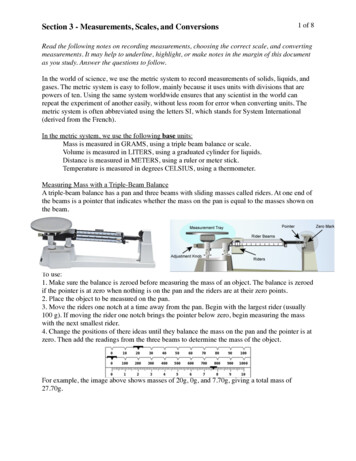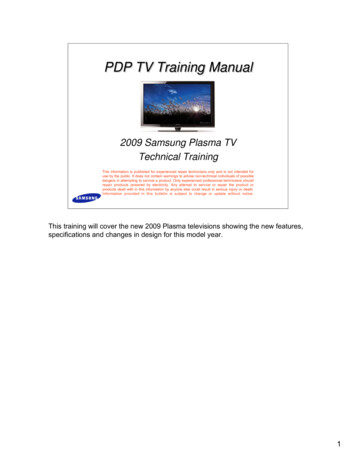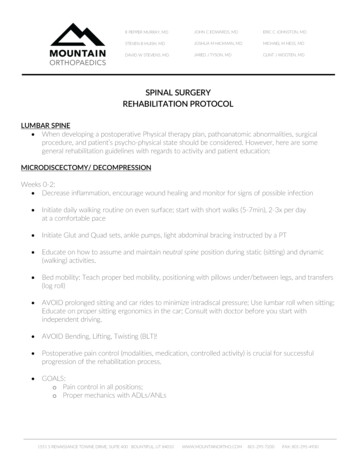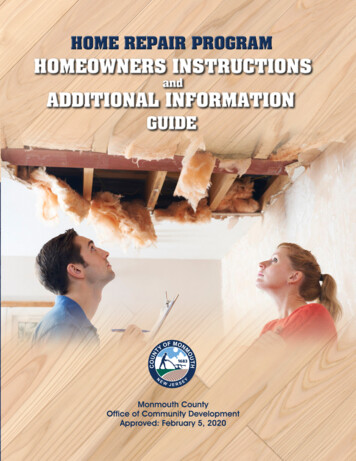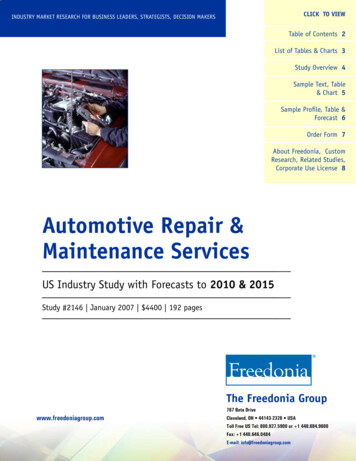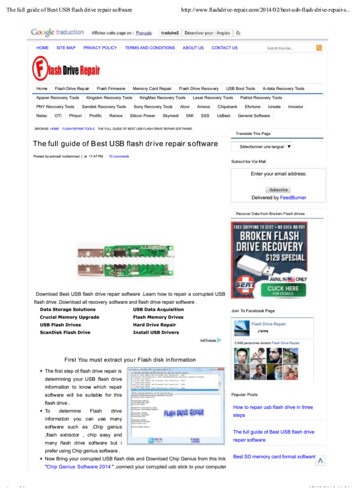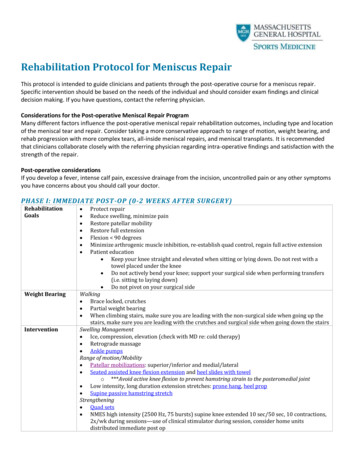
Transcription
Rehabilitation Protocol for Meniscus RepairThis protocol is intended to guide clinicians and patients through the post-operative course for a meniscus repair.Specific intervention should be based on the needs of the individual and should consider exam findings and clinicaldecision making. If you have questions, contact the referring physician.Considerations for the Post-operative Meniscal Repair ProgramMany different factors influence the post-operative meniscal repair rehabilitation outcomes, including type and locationof the meniscal tear and repair. Consider taking a more conservative approach to range of motion, weight bearing, andrehab progression with more complex tears, all-inside meniscal repairs, and meniscal transplants. It is recommendedthat clinicians collaborate closely with the referring physician regarding intra-operative findings and satisfaction with thestrength of the repair.Post-operative considerationsIf you develop a fever, intense calf pain, excessive drainage from the incision, uncontrolled pain or any other symptomsyou have concerns about you should call your doctor.PHASE I: IMMEDIATE POST -OP (0-2 WEEKS AFTER SURGERY)RehabilitationGoalsWeight BearingIntervention Protect repairReduce swelling, minimize painRestore patellar mobilityRestore full extensionFlexion 90 degreesMinimize arthrogenic muscle inhibition, re-establish quad control, regain full active extensionPatient education Keep your knee straight and elevated when sitting or lying down. Do not rest with atowel placed under the knee Do not actively bend your knee; support your surgical side when performing transfers(i.e. sitting to laying down) Do not pivot on your surgical sideWalking Brace locked, crutches Partial weight bearing When climbing stairs, make sure you are leading with the non-surgical side when going up thestairs, make sure you are leading with the crutches and surgical side when going down the stairsSwelling Management Ice, compression, elevation (check with MD re: cold therapy) Retrograde massage Ankle pumpsRange of motion/Mobility Patellar mobilizations: superior/inferior and medial/lateral Seated assisted knee flexion extension and heel slides with towelo ***Avoid active knee flexion to prevent hamstring strain to the posteromedial joint Low intensity, long duration extension stretches: prone hang, heel prop Supine passive hamstring stretchStrengthening Quad sets NMES high intensity (2500 Hz, 75 bursts) supine knee extended 10 sec/50 sec, 10 contractions,2x/wk during sessions—use of clinical stimulator during session, consider home unitsdistributed immediate post op
Criteria toProgress Straight leg raiseo **Do not perform straight leg raise if you have a knee extension lagHip abductionMulti-angle isometrics 90 and 60 deg knee extensionKnee extension ROM 0 degKnee flexion ROM 90 degreesQuad contraction with superior patella glide and full active extensionAble to perform straight leg raise without lagPHASE II: INTERMEDIATE POST-OP (3-5 WEEKS AFTER SURGERY)RehabilitationGoalsWeight BearingAdditionalIntervention*Continue withPhase IinterventionsCriteria toProgress Continue to protect repair Reduce pain, minimize swelling Maintain full extension Flexion 120 degreesWalking Continue partial weight bearing Consult with referring MD regarding unlocking braceRange of motion/Mobility Stationary bicycle: gentle range of motion only (see Phase III for conditioning)Cardio Upper body ergometerStrengthening Calf raises Lumbopelvic strengthening: sidelying hip external rotation-clamshell, plankBalance/proprioception Double limb standing balance utilizing uneven surface (wobble board) Joint position re-training No swelling (Modified Stroke Test) Flexion ROM 120 degrees Extension ROM equal to contra lateral sidePHASE III: LATE POST-OP (6-8 WEEKS AFTER SURGERY)RehabilitationGoalsWeight BearingAdditionalIntervention*Continue withPhase I-IIInterventions Continue to protect repairMaintain full extensionNormalize gaitFlexion within 10 degrees of contra lateral sideSafely progress strengtheningPromote proper movement patternsAvoid post exercise pain/swellingMay discontinue use of brace/crutches after 6 wks per MD and once adequate quad control isachievedRange of motion/Mobility Supine active hamstring stretch Standing gastroc stretch and soleus stretch Gentle stretching all muscle groups: prone quad stretch, standing quad stretch, kneeling hipflexor stretch Rotational tibial mobilizations if limited ROMCardio Stationary bicycle, flutter kick swimming, pool joggingStrengthening Partial squat exercise 0-60 degrees Ball squats, wall slides, mini squats from 0-60 deg Hamstring strengthening: prone hamstring curlsMassachusetts General Hospital Sports Medicine2
Criteria toProgressLumbopelvic strengthening: bridges on physioball, bridge on physioball with roll-in, bridge onphysioball alternating, hip hike Gym equipment: leg press machine, hip abductor and adductor machine, hip extension machine,roman chair, seated calf machine Progress intensity (strength) and duration (endurance) of exercisesBalance/proprioception Single limb balance progress to uneven surface including perturbation training No swelling/pain after exercise Normal gait ROM equal to contra lateral side Joint position sense symmetrical ( 5 degree margin of error)PHASE IV: TRANSITIONAL (9-12 WEEKS AFTER Continue withPhase I-IIIinterventionsCriteria toProgress Maintain full ROM Safely progress strengthening Promote proper movement patterns Avoid post exercise pain/swellingCardio Elliptical, stair climberStrengtheningo **The following exercises to focus on proper control with emphasis on good proximalstability Squat to chair Lateral lunges Single leg progression: partial weight bearing single leg press, slide board lunges: retro andlateral, step ups and step ups with march, lateral step-ups, step downs, single leg squats, singleleg wall slides Knee Exercises for additional exercises and descriptions Gym equipment: seated hamstring curl machine and hamstring curl machine Romanian deadlift No episodes of instability Maintain quad strength 10 repetitions single leg squat proper form through at least 60 deg knee flexion KOOS-sports questionnaire 70% Functional Assessmento Quadriceps index 80%; HHD mean preferred (isokinetic testing if available)o Hamstring, glut med,glut max index 80%; HHD mean preferred (isokinetic testing forHS if available)o Single leg hop test 75% compared to contra lateral side (earliest 12 wks)PHASE V: EARLY RETURN TO SPORT (3 -5 MONTHS AFTER Continue withPhase II-IVinterventions Safely progress strengtheningSafely initiate sport specific training programPromote proper movement patternsAvoid post exercise pain/swellingInterval running programo Return to Running ProgramProgress to plyometric and agility program (with functional brace if prescribed)o Agility and Plyometric ProgramMassachusetts General Hospital Sports Medicine3
Criteria toProgress Clearance from MD and ALL milestone criteria below have been metCompletion jog/run program without pain/swellingFunctional Assessmento Quad/HS/glut index 90%; HHD mean preferred (isokinetic testing if available)o Hamstring/Quad ratio 70%; HHD mean preferred (isokinetic testing if available)o Hop Testing 90% compared to contra lateral sideKOOS-sports questionnaire 90%International Knee Committee Subjective Knee Evaluation 93Psych Readiness to Return to Sport (PRRS)PHASE VI: UNRESTRICTED RETURN TO SPORT (6 MONTHS AFTER Continue withPhase II-VinterventionsCriteria toProgress Continue strengthening and proprioceptive exercisesSymmetrical performance with sport specific drillsSafely progress to full sportMulti-plane sport specific plyometrics programMulti-plane sport specific agility programInclude hard cutting and pivoting depending on the individuals’ goalsNon-contact practice Full practice Full play Last stage, no additional criteriaRevised January 2019ContactPlease call 617.643.9999 with any questions specific to this protocolReferencesAdams D, Logerstedt D, et al. Current Concepts for Anterior Cruciate Ligament Reconstruction: A Criterion-Based Rehabilitation Progression. JOSPT 2012 42(7): 601-614.DeFroda SF, Bokshan SL, et al. Variability of online available physical therapy protocols from academic orthopedic surgery programs for arthroscopic meniscus repair. The Physician and SportsMedicine. 2018. 46 (3): 355-360.Glazer DD. Development and Preliminary Validation of the Injury-Psychological Readiness to Return to Sport (I-PRRS) Scale. Journal of Athletic Training. 2009;44(2):185-189.Irrgang JJ, Anderson AF, Boland AL, et al. Development and validation of the International Knee Documentation Committee Subjective Knee Form. Am J Sports Med. 2001;29:600-613.Mandelbaum BR, Silvers HJ, Watanabe DS, et al. Effectiveness of a Neuromuscular and Proprioceptive Training Program in Preventing Anterior Cruciate Ligament Injuries in Female Athletes: 2year follow-up. Am J Sports Med. 2005;33:1003-1010.Noyes, FR, Heckmann TP, et al. Meniscus Repair and Transplantation: A Comprehensive Update. JOSPT 2012 42(3): 274-290.VanderHave KL, Perkins C, et al. Weightbearing versus nonweightbearing after meniscus repair. Sports Health. 2015. 7 (5): 399-402.Vedi V, Williams A, et al. Meniscal movement: an in-vivo study using dynamic MRI. JBJS. 1999. 81: 37-41.Wilk KE, Macrina LC, et al. Recent Advances in the Rehabilitation of Anterior Cruciate Ligament Injuries. JOSPT 2012 42(3): 153-171.Massachusetts General Hospital Sports Medicine4
Functional AssessmentPatient Name:MRN:Date of Surgery:Surgeon:Graft Type esBPTBOtherConcomitant Injuries/Procedures:Operative LimbNon-operativeLimbLimb SymmetryIndexRange of motion (X-0-X)-Pain (0-10)-Knee Effusion-Hamstring Strength (average/3 trials)Quadriceps Strength (average/3 trials)Hamstring : Quadriceps Ratio (as above)-Hop TestingSingle-leg Hop for DistanceTriple Hop for DistanceCrossover Hop for DistanceVertical JumpY-Balance TestCalculated 1 RM (single leg press)Psych. Readiness to Return to Sport (PRRS)Ready to jog?YESNOReady to return to sport?YESNORecommendations:Examiner:Massachusetts General Hospital Sports Medicine5
Range of motion is recorded in X-0-X format: for example, if a patient has 6 degrees of hyperextension and 135 degreesof flexion, ROM would read: 6-0-135. If the patient does not achieve hyperextension, and is lacking full extension by 5degrees, the ROM would simply read: 5-135.Pain is recorded as an average value over the past 2 weeks, from 0-10. 0 is absolutely no pain, and 10 is the worst painever experienced.Knee Effusion is tested using the Modified Stroke Test. An upstroke is applied to medial side of knee, followed bydownstroke on lateral side. The therapist observes for movement of fluid with each stroke.-0: no wave produced with downward strokeTrace: small wave of fluid on medial side of knee1 : large bulge of fluid on medial side of knee with downstroke2 : Effusion returns to medial side of knee without downstroke3 : inability to move effusion from medial side of kneeQuadriceps strength is measured using a handheld dynamometer. The patient is secured in 60 degrees of knee flexionand the HHD is placed between the patient’s tibia and the resistance arm, 1 inch proximal to the midline between themalleoli. The patient is instructed to apply a maximal isometric effort force the HHD and the average of 3 trials isrecorded for each limb.Hamstring strength is measured using a handheld dynamometer. The patient is secured in 60 degrees of knee flexionand the HHD is placed between the patient’s lower leg and the resistance arm, 1 inch proximal to the midline betweenthe malleoli. The patient is instructed to apply a maximal isometric force against the HHD and the average of 3 trials isrecorded for each limb.Hamstring:quadriceps ratio is calculated for each limb based on the average of 3 trials for flexion and extension,respectively. The average isometric hamstring strength is divided by the average quadriceps strength.Hop testing is performed per standardized testing guidelines. The average of 3 trials is recorded to the nearestcentimeter for each limb.Massachusetts General Hospital Sports Medicine6
Return to Running ProgramThis program is designed as a guide for clinicians and patients through a progressive return-to-run program. Patientsshould demonstrate 80% on the Functional Assessment prior to initiating this program (after a knee ligament ormeniscus repair). Specific recommendations should be based on the needs of the individual and should consider clinicaldecision making. If you have questions, contact the referring physician.PHASE I: WARM UP WALK 15 MINUTES, COOL DOWN WALK 10 MINUTESDay1Week 1W5/J1x5Week 2Week 4/J2x5W2/J4x5W1/J5x5Returnto RunKey: W walk, J jog**Only progress if there is no pain or swelling during or after the runPHASE II: WARM UP WALK 15 MINUTES, COOL DOWN WALK 10 MINUTESWeekSunday120 min238Wednesday20 min30 min55 min35 min40 min45 min50 min55 min60 min25 min35 min45 minSaturday30 min40 min50 minFriday20 min30 min40 minThursday25 min35 min67Tuesday25 min45Monday45 min50 min55 min60 min60 minRecommendations Runs should occur on softer surfaces during Phase I Non-impact activity on off days Goal is to increase mileage and then increase pace; avoid increasing two variables at once 10% rule: no more than 10% increase in mileage per weekMassachusetts General Hospital Sports Medicine7
Agility and Plyometric ProgramThis program is designed as a guide for clinicians and patients through a progressive series of agility and plyometricexercises to promote successful return to sport and reduce injury risk. Patients should demonstrate 80% on theFunctional Assessment prior to initiating this program. Specific intervention should be based on the needs of theindividual and should consider clinical decision making. If you have questions, contact the referring physician.PHASE I: ANTERIOR PROGRESSIONRehabilitationGoalsAgilityPlyometrics Criteria toProgress Safely recondition the kneeProvide a logical sequence of progressive drills for pre-sports conditioningForward runBackward runForward lean in to a runForward run with 3-step decelerationFigure 8 runCircle runLadderShuttle press: Double leg alternating leg single leg jumpsDouble leg:o Jumps on to a box jump off of a box jumps on/off boxo Forward jumps, forward jump to broad jumpo Tuck jumpso Backward/forward hops over line/coneSingle leg (these exercises are challenging and should be considered for more advancedathletes):o Progressive single leg jump taskso Bounding runo Scissor jumpso Backward/forward hops over line/coneNo increase in pain or swellingPain-free during loading activitiesDemonstrates proper movement patternsPHASE II: LATERAL PROGRESSIONRehabilitationGoalsAgility*Continue withPhase IinterventionsPlyometrics*Continue withPhase IinterventionsCriteria toProgress Safely recondition the kneeProvide a logical sequence of progressive drills for the Level 1 sport athleteSide shuffleCariocaCrossover stepsShuttle runZig-zag runLadderDouble leg:o Lateral jumps over line/coneo Lateral tuck jumps over coneSingle leg(these exercises are challenging and should be considered for more advancedathletes):o Lateral jumps over line/coneo Lateral jumps with sport cordNo increase in pain or swellingPain-free during loading activitiesDemonstrates proper movement patternsMassachusetts General Hospital Sports Medicine8
PHASE III: MULTI-PLANAR PROGRESSIONRehabilitationGoals Challenge the Level 1 sport athlete in preparation for final clearance for return to sportAgility*Continue withPhase I-IIinterventionsPlyometrics*Continue withPhase I-IIinterventionsCriteria toProgress Box drillStar drillSide shuffle with hurdles Box jumps with quick change of direction90 and 180 degree jumps Clearance from MDFunctional Assessmento Quad/HS/glut index 90% contra lateral side (isokinetic testing if available)o Hamstring/Quad ratio 70%o Hop Testing 90% contralateral sideKOOS-sports questionnaire 90%International Knee Committee Subjective Knee Evaluation 93Psych Readiness to Return to Sport (PRRS) Massachusetts General Hospital Sports Medicine9
Massachusetts General Hospital Sports Medicine10
Massachusetts General Hospital Sports Medicine11
Massachusetts General Hospital Sports Medicine12
Massachusetts General Hospital Sports Medicine13
Massachusetts General Hospital Sports Medicine14
Massachusetts General Hospital Sports Medicine15
Psychological Readiness to Return to SportPatient Name:MRN:Surgery:Date of Surgery:Surgeon:Please rate your confidence to return to your sport on a scale from 0 – 100Example:0 No confidence at all50 Moderate confidence100 Complete confidence1. My overall confidence to play is2. My confidence to play without pain is3. My confidence to give 100% effort is4. My confidence to not concentrate on the injury is5. My confidence in the injured body part to handle demands of the situation is6. My confidence in my skill level/ability isTotal:Score:Examiner:Glazer DD. Development and Preliminary Validation of the Injury-Psychological Readiness to Return to Sport (I-PRRS) Scale. Journal of Athletic Training. 2009;44(2):185-18Massachusetts General Hospital Sports Medicine16
Rehabilitation Protocol for Meniscus Repair This protocol is intended to guide clinicians and patients through the post-operative course for a meniscus repair. Specific intervention should be based on the needs of the individual and should consider exam findings and clinical decision making. If you have questions, contact the referring physician.
